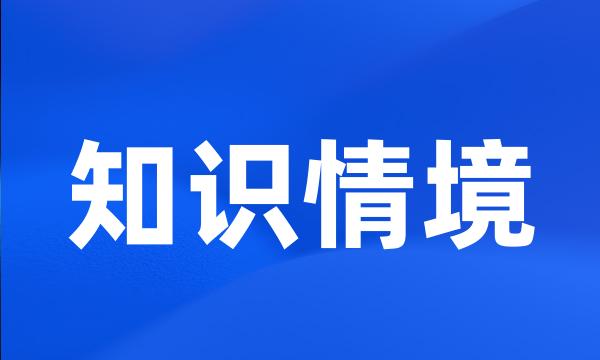知识情境
- 网络knowledge context
 知识情境
知识情境-
该模型由知识情境、知识过程、知识(项)和知识主体4个主要知识管理要素构成。
This model was composed of four main KM components : knowledge context , knowledge process , knowledge ( item ) and knowledge agent .
-
基于知识情境的知识重用与创新机制研究
Study on Knowledge Reuse and Innovation Based on Knowledge Scenario
-
虚拟演示实验中知识情境的构建研究
Study on Knowledge Situation Construction of Virtual Demonstration Experiment
-
在树型结构的基础上设计了知识情境相似度算法。
Based on the presented tree-structure , this paper designs an algorithm to calculate similarities between knowledge contexts .
-
通过促销知识情境要素提取和建模为相关研究提供了定量分析基础。
Because of promotion context elements selection and modeling , a quantitative analysis basis of related researches has been provided .
-
这个过程也就是学习者在知识的情境化中不断拓展自己、超越自己的过程。
That process means the learners continuously explore and surpass themselves in the situation of knowledge .
-
研究结果表明,知识转移情境的不同,对外部新技术的获取绩效有重要影响。
The study found strong evidence that the external / internal knowledge transfer situation has significant influence on the performance of the acquisition of external technology .
-
另外,考虑到组织学习的场的重要作用,需要加强对场的完善,以便为组织学习提供合理便利的知识交流情境。
In addition , considering the vital role of Ba in organizational learning , we need strengthen improvement on Ba , so as to provide organizational learning with a reasonable and convenient situation for knowledge exchange .
-
企业知识转移的情境分析模型
Context-based model of knowledge transfer in firms
-
化学教材中知识呈现方式情境化的意义
Knowledge Presenting in Chemistry Teaching Material
-
知识是具有情境性的。
Knowledge is characterized by situation .
-
话语的语用含义包含语言知识,交际情境,人们的社会知识,和文化心理。
The pragmatic implicature of discourse involves linguistic knowledge , communicative context , social knowledge and cultural psychology .
-
基于情境认知的数学命题教学使学生有可能在真实的、逼真的活动中,通过观察、概念工具的应用以及问题的解决,来提高学习的有效性,并保证知识向真实情境的转移。
Sit cog-based mathematical proposition teaching make it probable that students study more effective and avert their knowledge to reality situation .
-
情境抛锚是将知识镶嵌在情境中呈现,使学生获得知识的弹性,情境镶嵌的知识更易于迁移。
Anchor is the knowledge embedded in the context of situation , causes the student to obtain knowledge ," elastic " situational embedded knowledge more easy migration .
-
情境理论认为知识是具有情境性的,强调认知和学习的交互特性和实践的重要性。
The situation theory thinks that the knowledge is situated and it also emphasizes the importance of practice , as well as the interaction characteristic of the cognition and study .
-
在教学过程中,教师的注意力从传播知识转向营造情境、激发兴趣、引导探究和评价上来,教师是学生的引导者,让学生主动、能动地学习和发展。
In the course of teaching , the function of teachers changes into stiring up students ' interest and leading them to investigate and evaluate from passing on the knowledge .
-
建构主义理论支持下的教学设计不仅要进行教学目标分析,还要考虑创设有利于学生建构知识意义的情境。
The making of teaching designs based on this theory requires the analysis of teaching goals as well as the creation of a'scene'which is helpful for students to construct the knowledge .
-
20世纪80年代以来,西方通过概念性的和分析性的教师知识研究与情境性和实践性的教师知识研究两种研究路径揭示教师知识的基本结构。
Since 1980s , the basic structure of teachers ' knowledge has been revealed in the west by two approaches , i. e. conceptual and analytical research and situational and practical research .
-
第三,知识转移的情境因素独立于其它三类影响要素,对企业间知识转移的过程和效果均产生直接和间接的作用。
Third , the context of knowledge , independent of the other three elements and affecting directly as well as indirectly the process and effectiveness of knowledge transfer among enterprises , include the two dimensions of micro context and medium context .
-
所以教师应该从以下几个方面来改进:提高情境教学的理论知识和运用情境教学的能力;多种情境设计方法灵活综合运用;尊重学生的主体地位,把握好情境设计等。
Teachers should be improved from the following aspects : To improve the situational teaching theoretical knowledge and ability to use contextual teaching ; use the method of contextual design flexible andintegrated ; pay more attention to the subjective status of students , balance the using of contextual design .
-
现代学习理论认为人的知识离不开情境,它是在一定的情境中产生并发展的。
Modern learning theory thinks that the human knowledge comes out and develops in some kind of situations .
-
第二部分主要从科学知识形成的社会情境、研究方法和对科学特征的表述三个方面,对二者所持的不同科学知识观进行了比较。
The second part mainly compares the social situations in which scientific knowledge forms , the research methods and the attitude to scientific knowledge .
-
有关认知与学习的情境理论已成为一种能提供有意义的学习并促进知识向真实生活情境转化的重要学习理论。
The theory of project-based learning about cognition and learning has become an important learning theory which can offer meaningful learning and promote the change of knowledge into real living situation .
-
就数学学科学习材料内容而言,大致可以分为三大部分,一是知识的引入(情境的创设)与分析讲解(理解获得知识);
The study material content in mathematics is roughly divided into three major parts : first , introduction of knowledge ( situation open ) and its analysis and explanation ( understand and obtain the knowledge );
-
其方法是引导读者进入知识生产的特定情境,引导读者在专业发展的轨迹中阅读,引导读者以系统的专业知识为背景进行阅读。
It is to guide readers into special situations of knowledge production , guide readers to reader along the paths of the sciences , and guide readers to read in the background of systematic knowledge .
-
随着建构主义理论研究和应用的不断深入,有关认知与学习的建构主义情境理论,已经成为一种能提供有意义学习并促进知识向真实生活情境转化的重要学习理论。
With the Construction Research and Application of the theory of the continuous deepening of the cognitive and learning theory of constructivism situation has become to provide a meaningful learning and to promote knowledge to real-life situations into an important theoretical study .
-
个人心理活动参与下形成的个人知识、学科问题情境的经验、人在处理学科问题时的心理思维操作,这三者是学科能力的核心心理要素。
There are 3 key psychological elements in subject abilities : the " individual knowledge " formed with the individual participation in psychological activities , the situational experiences of the subject problems , the psychological thinking and practice in solving problems of the subject .
-
该过程包括设计知识获取、案例情境构建、设计情境组织模型构建、情境转化模型构建和模型实现验证五个阶段,以形成一个需求标识、需求转化、模型建立、模型评估和验证的设计流程。
The whole construction process includes five stages : design knowledge acquiring , case scenario construction , design scenario organization , scenario transformation model construction and its application of the model , which form a complete requirements identification , requirements transformation , model construction and model evaluation .
-
用维尔伯意识谱理论整合了广义知识加工理论、情境认知理论、人本主义学习理论、脑的教育研究等多种学习理论,并在这些理论基础之上,提出了基于三维目标的化学教学策略。
Wilber consciousness spectrum theory integrates these theories ' distillation which includes the theory of generalized knowledge processing , situated cognitive , humanistic learning and brain-based education study , and offers the teaching strategies of chemistry based on three-dimensional objective on the basic of these theories . 3 .
-
分析了产品设计知识的整合要求,提出了集知识载体、知识内容和知识情境为一体的知识建模技术。
After analyzing the demands of product design knowledge integration a knowledge model is introduced which include knowledge carrier and knowledge information and knowledge scenario .
